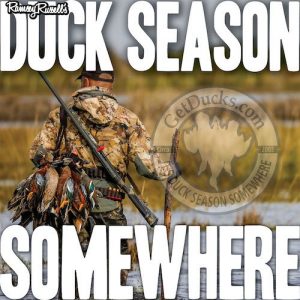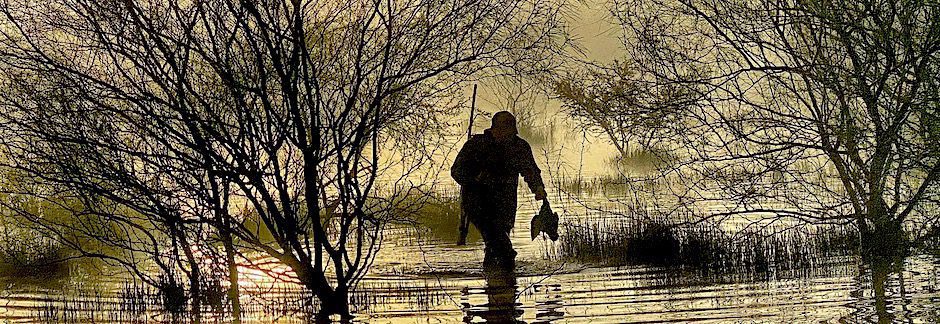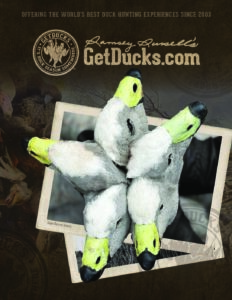MOJO’S Duck Season Somewhere Podcast
Amid the Cypress with Jim Crews

Jim Crews has been hunting amid ancient Mississippi cypress for 5 decades, forgetting neither his first hunt nor his first duck. Having recently published his must-read duck hunting memoir Amid the Cypress, that describes memorable ducks hunts in Mississippi and far beyond, Crews and Ramsey recall times shared in cypress-studded north Mississippi Delta oxbows. What compelled Crews to write a duck hunting book? Why was Bobo Brake the apropos setting for duck hunting with Ramsey’s heirloom Colt hammer-gun? Does he recommend squeezing in a duck hunt before a wedding? How did some infamous duck hole names, like Propellor Hole, originate? What kinds of duck decoys might Crews be hunting over on any given day and why does it matter – or does it? Why does practical, old-school duck hunting styles resonate with him? How’d he end up hosting a couple Maltese hunters? Did cleaning his trusty two-shooter killing stick pass the muster in Scotland? Like gadwalls filtering intermittently into cypress timber on a blue-bird morning, this conversation between buddies is the perfect pace.
More info: Interested in purchasing a copy of Amid the Cypress? Contact Jim Crews through Facebook or call 601-859-2511.
Mississippi Hunting, True Hospitality, and Making Time for People

Having shared duck blinds in many places worldwide with Chris Gouras, I can tell y’all for fact that there’s never been a lack of good things to talk about between volleys. The descendant of Greek immigrants, he’s been around the restaurant industry since forever, and started duck hunting among true South Delta legends soon after moving to Mississippi. How’d Big John end up facing the wrong way in a Netherlands goose blind? Who were some of the colorful characters Gouras hunted with back in the good old days? What happened the morning he hunted with a former Mississippi Governor? Why does he say, “Mississippi has time for people?” How important are good eats at Gouras’s hunting camp? Who’s the fastest draw in a deer stand – Chris Gouras or Ramsey Russell? What’d Gouras’s father insist be rescued from his home office preceding an incoming hurricane, and what was he the world’s best at catching? How muddy was the drive to Rio Salado last time Gouras visited and why’s he still going back? Past, present and future times covered, all awesome, like every single time we’ve ever hunted together.
More Father’s Day Grandad Russell Stories with Uncle James

Leading up to Father’s Day, Ramsey met with his Uncle James to talk about his grandfather Russell, the one that introduced him to hunting. In addition to some of the stories he heard around the dinner table growing up, he learned a few more.
Uncle James’s Father’s Day Stories About Granddad

Preceding Father’s Day, Ramsey Russell meets with his 75 year-old Uncle James Russell who shares some stories about growing up in the Mississippi Delta. It’s been decades since the grandfather that introduced Ramsey to hunting passed. As the two of them recount family stories shared around the dinner table, Ramsey learns the origins of his grandfather’s shotgun and a lot more.
Duck Updates, Delta Waterfowl’s John Devney

During a recent visit to Mississippi, Delta Waterfowl John Devney and Ramsey Russell discussed need-to-know duck topics. How dry is the Prairie Pothole Region, what will ducks do, how exactly might it affect waterfowl reproduction, and why isn’t Plan B Alaska nesting as productive? What’s the backstory on North Dakota’s new e-posting rulings, what prompted it, and how’d Delta Waterfowl bring common sense to the table? What ever became of Maryland’s HB 0911 that would have marginalized boat hunters on Susquehanna Flats? Due to covid-related Canadian border closures, waterfowl population surveys and banding activities have been cancelled for the 2nd consecutive year. Will hunting be like writing checks without knowing our account balance? And finally, why might a 3-pintail daily bag limit make sense? Super informative episode.
The Mississippi Delta Blues

From a 1900’s-era commissary on the edge of a sprawling cotton field, about a half-hour north of where Delta bluesman Robert Johnson supposedly sold his soul to the devil, Hank Burdine tells Ramsey Russell about the origins of the Mississippi Delta blues. The precursor to rock-n-roll, this music genre was also true inspiration of the recognized king himself, Elvis Presley. It’s more the fascinating story of people, culture, time and place than of distinct, metal-stringed notes emanating from sweaty juke joints. And from personal experiences and past friendships, nobody but nobody tells it better than Mississippi Delta raconteur Hank Burdine. Please subscribe, rate and review Duck Season Somewhere podcast. Share your favorite episodes with friends!
Will Canada Be Open to US Waterfowl Hunters?!

When will Canada borders reopen to non-Canadian waterfowl hunters? It’s the question we’ve been asking ourselves for over a year. Ramsey Russell is joined today by USHuntList associate, Ryan Reynolds of Apex Waterfowling in Ontario. They discuss pandemic effects in Canada. What’s Canada look like right now, who’s been hunting and where? How are successful Canadian waterfowl outfitters like Ryan Reynolds coping with the border closure – and how has affected many other outfitters? What’s the covid status among provinces (late-May)? What has to happen for Canadian borders to reopen? How might things be different for freelancer hunters? Informative Duck Season Somewhere podcast episode that left me thinking, “So you’re telling me there’s a chance,” like Dumb and Dumber Jim Carey’s voice.
What About Guided North Dakota Waterfowl Hunting?

Matt Piehl and Ramsey Russell meet between North America waterfowl hunting seasons to discuss guided waterfowl hunts in general, exciting Dirty Bird Outfitter developments, and new important private property e-posting laws that all duck and goose hunters planning to visit North Dakota should be fully aware. What recent life changes make Piehl feel like he jumped from frying pan into the skillet busy-wise? How was Arkansas spring snow goose hunting? What’s North Dakota habitat looking like? How will Dirty Bird Outfitters’ new lodge be a real game-changer? What will head-guide-and-Viking Nick Marcyes’ kitchen duties be?! What do new North Dakota’s new e-posting laws entail? All good stuff to know while waiting on season to get here.
Mr. Jim Clermont Remembering D-Day

On June 6, 1944, Allied Forces launched an all-out naval, air and land assault on Nazi-occupied France. It was the turning point in WW2. On that day in history, Mr. Jim Cleremont was aboard the USS Herndon, only 3,000 yards off Omaha Beach during the invasion. Mr. Cleremont recalls growing up in Minnesota, joining the Navy, and his time in service. He remembers events aboard the USS Herndon before, during and after the battle, and tells about revisiting Normandy in 2014. In his book The World’s Greatest Generation, Tom Brokaw argues that these Americans fought not for fame and recognition, but because it was the “right thing to do.” Mr. Cleremont is one such American patriot, describing who he believes to be the true heroes. A sobering reminder preceding the 77th anniversary of D-Day.
Boss Shotshells Happenings

Brandon Cerecke breaks from managing waterfowl habitat and satisfying customer demands for the growing product-line of Boss Shotshells copper-plated bismuth ammo. Why the global ammo shortage? Can you prepare? What’s Boss Shotshells doing about it? After 3 decades of bigger-faster, steel shot-science, why is Boss’s moving further in the opposite direction with their new “Stinger loads” – and why are the patterns even better? What’s driving new fiber-wad shotshell production? Only 3 years after crashing meteorically onto the waterfowl hunting ammo scene, how has Boss business culture evolved? How has an otherwise product-oriented business transformed Brandon’s true life purpose? Like full-choked, copper-plated bismuth patterns swatting paddles-down honkers over decoys, this Duck Season Somewhere episode crushes. Whether you’re a long-time user or curiously interested in what the Boss Shotshell movekent is about, you’ll enjoy listening!








